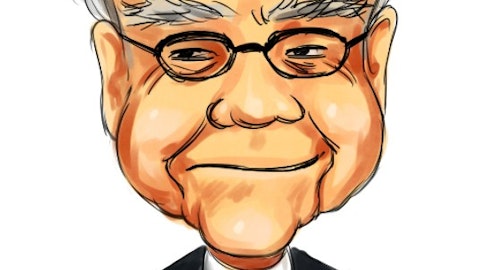Wal-Mart Stores, Inc. (NYSE:WMT) generated revenues of $484 billion over the last 12 months.
If Wal-Mart were a country (assuming revenue is about equal to GDP), it would be the 28th largest in the world.
Compare Wal-Mart’s 12 month sales totals to its peers:
– Wal-Mart sales of $484 billion
– Target Corporation (NYSE:TGT) sales of $74 billion
– Costco Wholesale Corporation (NASDAQ:COST) sales of $117 billion
– Amazon.com, Inc. (NASDAQ:AMZN) sales of $101 billion
Wal-Mart generates 165% of the sales of Target, Costco, and Amazon combined.
Not only does Wal-Mart have more revenues than these 3 companies combined, it also has the highest profit margin.
Target, Costco, and Amazon have a collective market cap of $408 billion (around $300 billion just for Amazon), whereas Wal-Mart has a market cap of $206 billion.

Wal-Mart is one of the most popular retailers among institutional investors. Out of some 730 funds tracked by Insider Monkey, 61 reported long positions in the company as of the end of the third quarter, having amassed stakes with a total value of $7.09 billion, which represented some 3.40% of the company. However, between July and September, the stock lost some popularity, since at the end of June, 65 funds held around $8.52 billion worth of the company’s shares. Billionaire Warren Buffett’s Berkshire Hathaway is one of the largest shareholders of Wal-Mart, holding some 55.19 million shares, according to its last 13F filing.
Current Events – The Bad and the Good
The reason Wal-Mart is so much cheaper than its peers is because the company is anticipating declining earnings-per-share for 2 years.
This decline is due to the company raising the salaries of its employees – likely in an attempt to reduce employee turnover and stem the backlash against the company’s infamous low wages.
Wal-Mart is also investing heavily in digital sales – which are not yet profitable. This is causing a drag on company earnings. As digital sales scale, they will become profitable and supplement Wal-Mart’s profits from its physical stores.
Negative news has caused Wal-Mart’s stock price to decline by 24% over the last 12 months.
Not all news surround Wal-Mart is bad.
The company’s share price is recovering from lows. Wal-Mart stock is up over 12% in the last quarter – while the S&P 500 is down 8% over the same time period.
The company’s latest (3rd quarter) earnings release was generally positive.
Constant currency revenue grew 2.8% for the company.
Comparable store sales in United States Wal-Mart stores grew 1.5%, the 5th consecutive quarter of increases.
As mentioned above, rising wages and heavier digital investment caused operating income to decline 8.8% versus the same quarter.
Wages will not continue to rise at such a rapid clip. The company’s margins will stabilize and recover, while improvements will likely cause revenue (and eventually earnings) to increase as well.
Wal-Mart’s Competitive Advantage
Wal-Mart’s competitive advantage is its “Everyday Low Prices” strategy.
Wal-Mart is the largest retailer in the world. It commands the best prices from its suppliers. The company pressures suppliers to lower their prices and then passes savings on to consumers which results in a positive feedback loop.
Wal-Mart’s efficient supply chain helps the company save money on transportation. The core philosophy of Wal-Mart is to give customers the best deals possible. That is what the company is based on, and that is how Wal-Mart has grown to be so successful.
Wal-Mart’s competitive advantage is very easy to grasp. The company’s business model is very simple. Warren Buffett is an advocate of easy-to-understand businesses with strong competitive advantages. Perhaps that’s why Wal-Mart is one of Warren Buffett’s largest holdings.




